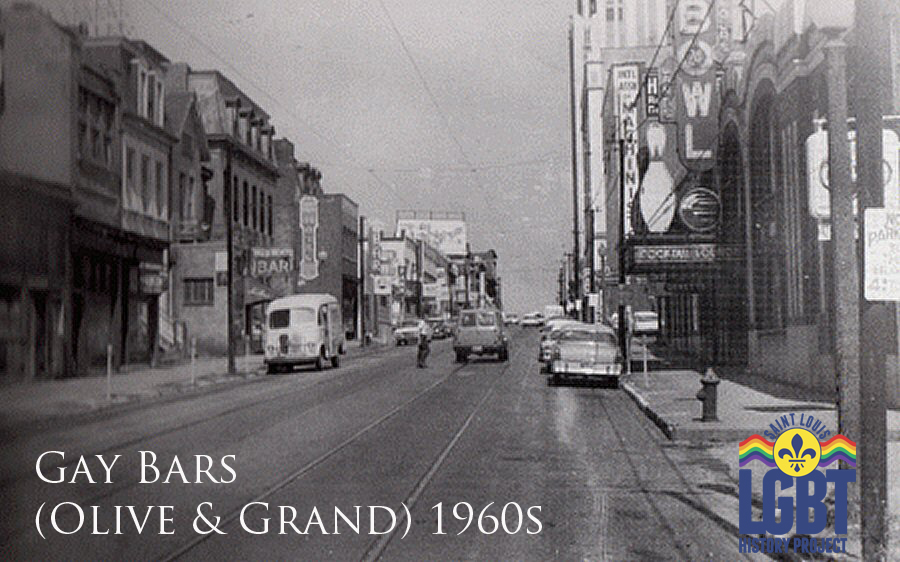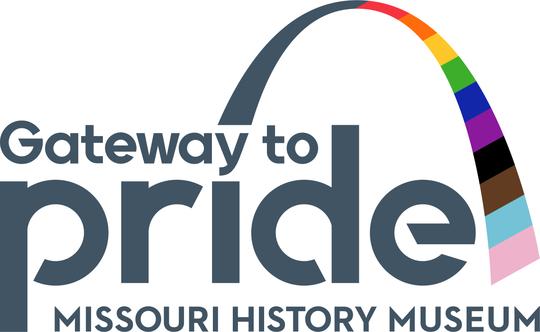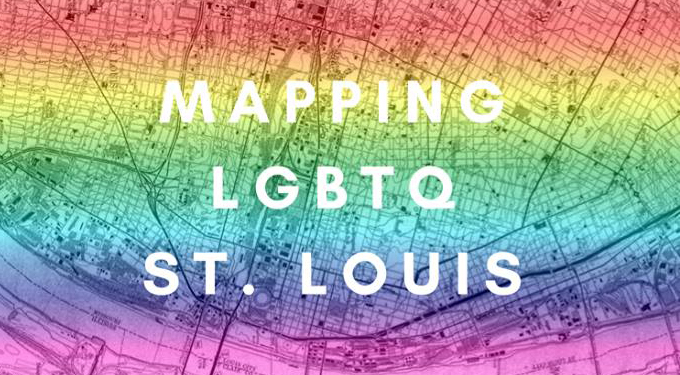A Historic Halloween: Remembering the Origins of the LGBT Movement in St. Louis
![]() By Ian Darnell
By Ian Darnell
October 31, 2014: Tonight we celebrate the 45th anniversary of a pivotal event in St. Louis LGBT history. More than any other single date, Halloween 1969 can be said to be when a movement for the rights of LGBT people began in the Gateway City.
On the night of Friday, October 31, plainclothes officers from the St. Louis police department's vice squad waited outside a gay bar called the Onyx Room.
Vice officers, who typically concentrated on policing female sex workers, also enforced laws against gender nonconformity and homosexuality. At the time, it was illegal for people to wear the clothes of the opposite sex or to have sex with someone of the same sex.
The Onyx Room was on Olive Street near Grand Boulevard, not far from the Fox Theatre and Saint Louis University (picture below). It was on the eastern edge of the "gay ghetto," a part of St. Louis that largely overlapped with the Central West End.
The neighborhood had a high concentration of LGBT residents and bars and other places where queer people gathered. LGBT people from all around the St. Louis region and beyond came to the gay ghetto to meet and socialize with others like themselves.
Soon after midnight, a group of nine male-bodied people wearing wigs, evening gowns, women's earrings, and high-heeled shoes exited the Onyx Room. (Available sources suggest that these people identified as men, but it is possible that some were trans women.) The vice officers promptly arrested them. One account implies that the police had been at the ready in front of the bar as part of a planned crackdown on LGBT nightlife. Similar arrests also took place that night across the Mississippi River in East St. Louis, which had several lesbian and gay bars of its own.
According to a police report, the nine people arrested in front of the Onyx Room were all young, ages 18-25. All worked low-paying, low-prestige jobs, were students, or were unemployed. Seven were white, and two were black. Most lived in the city of St. Louis, but one was from the nearby suburb of Webster Groves, and three were visiting from out of town.
The vice officers took them to jail at police headquarters downtown, where they were fingerprinted, photographed for mug shots, held on a cash bond of $50 each (approximately $325 today), and charged with "masquerading," that is, cross-dressing. They said that "they were insulted by the arresting officers, roughly treated in the police van, and made the objects of jokes and derision in the jail."
Up to this point, the night's events weren't very unusual. Historical newspaper reports show that St. Louis authorities, like their counterparts in other cities, had been policing queer people since at least the late nineteenth century. Oral histories and other sources recount police raids of "fruit" bars and harassment of gender-nonconforming people throughout the 1950s and '60s.
To be queer in these years meant risking abuse at the hands of police, arrest, and even imprisonment. Being arrested could mean public exposure resulting in loss of employment and alienation from family and friends. The Halloween arrests were just the latest example of this pattern. What was different about that night, however, is that an organized community fought back.
In the United States, the movement for the rights of lesbians and gay men began in California in the early 1950s. In the following years, some people in the St. Louis region were members of national organizations like the Mattachine Society and ONE, Inc.
There were some efforts to launch a locally based lesbian and gay rights group in St. Louis. Nothing got off the ground, however, until April 1969, when a small group of activists met in a Central West End apartment and founded the Mandrake Society. Its aim was "equalizing the status and position of the homosexual with the status and position of the heterosexual."
Among its first members was Laud Humphreys, a married, half-closeted Episcopal priest and sociology PhD from Washington University. Humphreys later wrote Tearoom Trade, a pioneering and controversial study of men who had anonymous sex with other men in the public restrooms of Forest Park.
Through the summer and early autumn of 1969, Mandrake made plans, held meetings, and attempted to spread word about its mission at local bars. But until Halloween night, it remained a small and obscure organization.
In the early hours of November 1, a raucous group of about two dozen people assembled in the lobby of police headquarters to protest the arrests and to free those in jail. The police threatened to charge the protesters with disturbing the peace. Some had come directly from the bars after hearing about the arrests, while others had come after receiving a call from a Mandrake phone chain. Humphreys and the president of the Mandrake Society were among those on the scene. The leaders of Mandrake negotiated with the police and helped raise bail.
The prisoners were released by 8 a.m., although only after their records were checked against FBI files. Some—still wearing makeup and women's clothes—were picked up from jail by distraught parents who had had no idea what their children had been up to the night before.
The response to the Halloween night arrests was unprecedented and marked a turning point in the history of St. Louis' LGBT community. As far as we know, never before had a large, self-consciously political group of queer people in St. Louis publicly gathered to confront authorities and to protest unfair treatment. Mandrake's membership expanded dramatically in the aftermath of the arrests. Around 150 people attended its November meeting, and it had more than 100 dues-paying members by January 1970. Mandrake hired an attorney to represent the nine people arrested for masquerading, and at the start of 1970 the attorney convinced a judge to drop the charges—a crucial early legal victory for St. Louis' LGBT activists.
Energized by these developments, Mandrake's members began to put out a newsletter (the first locally oriented LGBT publication in St. Louis), to hold drag fundraisers, and to work to combat anti-LGBT discrimination in a variety of areas of life. This organizing kicked off a period of vibrant LGBT activism in St. Louis in the 1970s and helped lay the foundation for the visible and politically influential LGBT community of today.
Click here for a St. Louis Public Radio story on the Halloween 1969 arrests. It includes an interview with Gregory Smith (picture above) who was charged with masquerading that night.
Do you have a story of your own about trouble with the police or other aspects of St. Louis' LGBT history? We want to hear it. Contact the St. Louis LGBT History Project today.
Image above: Gregory Smith on the night of the 1969 arrests.
Image below: Olive & Grand, a St. Louis gay bar district in the 1950s & 1960s (Onyx Room bar was located on the left side of street).






